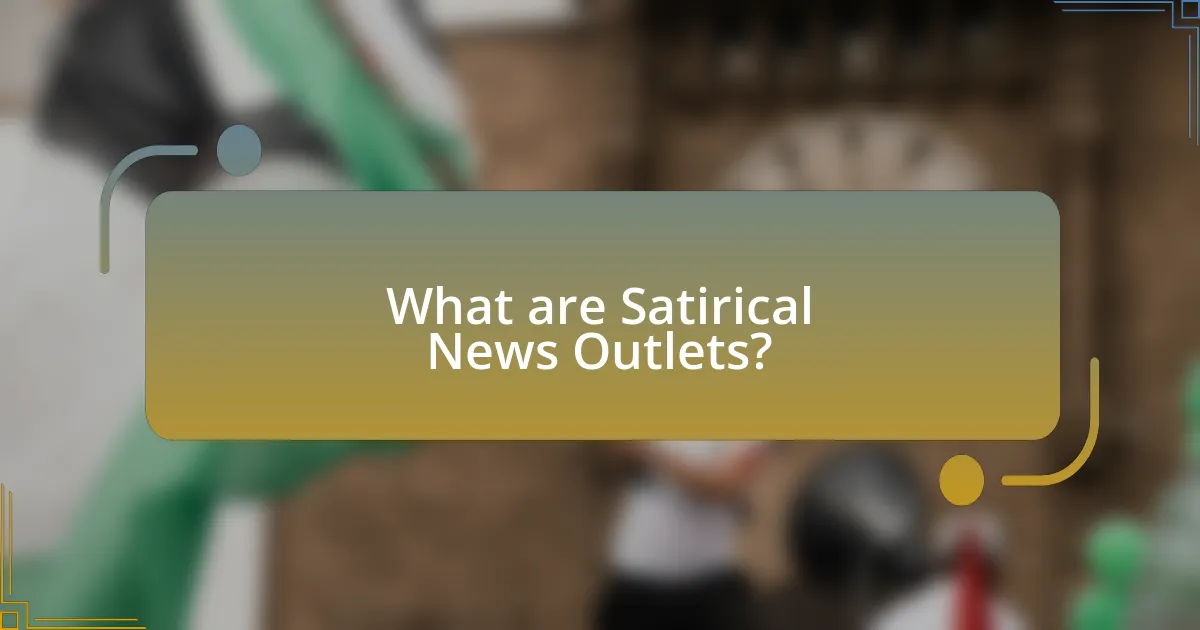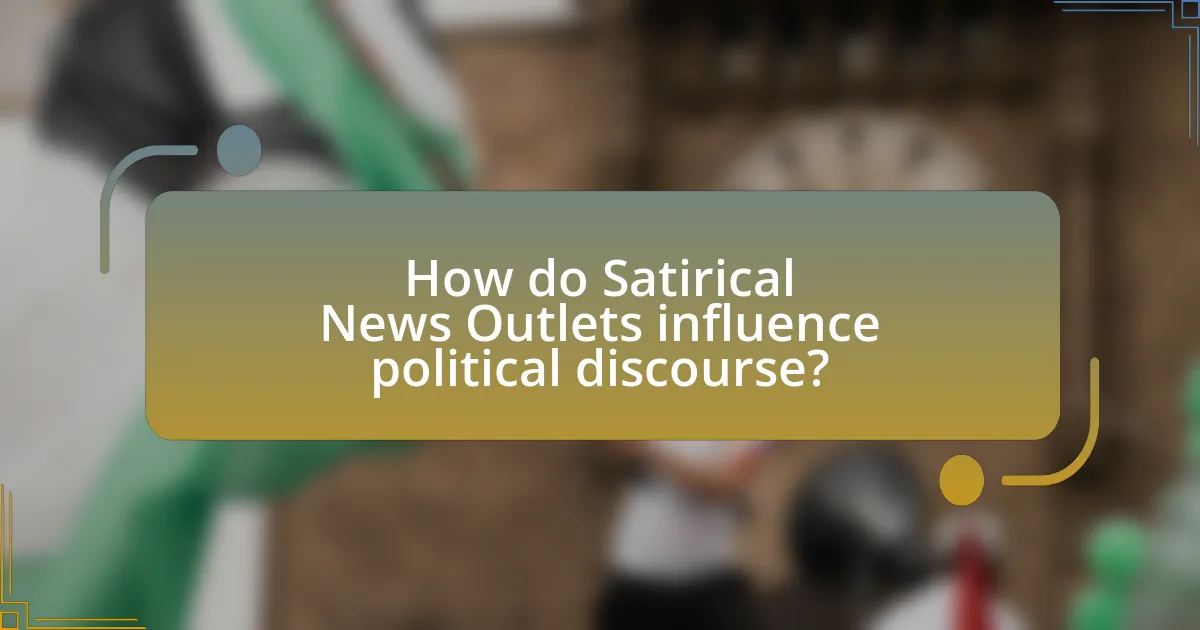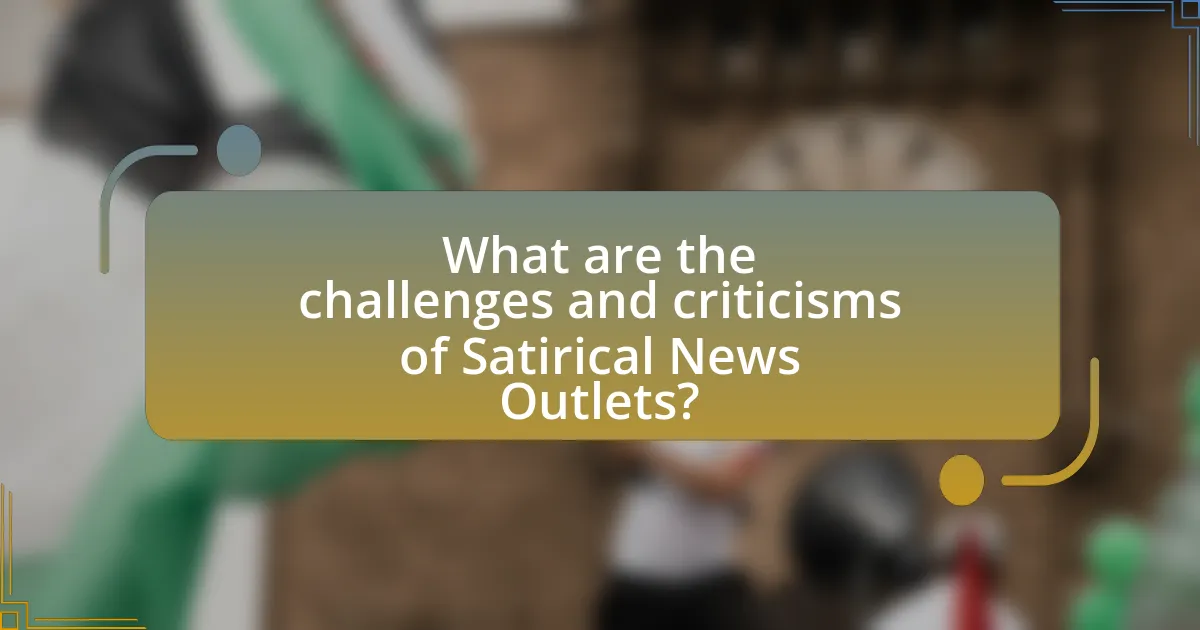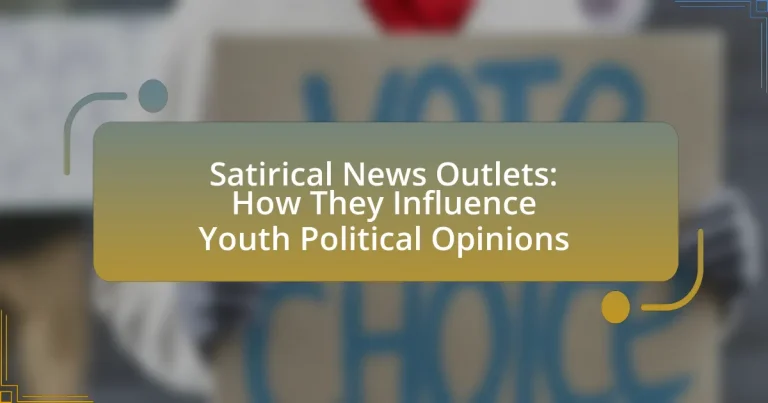Satirical news outlets, such as The Onion and The Babylon Bee, utilize humor, irony, and exaggeration to comment on current events and societal issues, often influencing public opinion, particularly among younger audiences. This article explores the differences between satirical and traditional news sources, the defining characteristics of satirical news, and its impact on youth political opinions and engagement. It also addresses the challenges and criticisms faced by satirical news, including the potential for misinformation and audience misunderstanding, while highlighting the importance of critical engagement and media literacy among young consumers.

What are Satirical News Outlets?
Satirical news outlets are media platforms that use humor, irony, and exaggeration to comment on current events and societal issues. These outlets, such as The Onion and The Babylon Bee, often present fictional news stories that mimic traditional journalism while providing social critique. Their purpose is to entertain while provoking thought about political and cultural topics, often highlighting absurdities in real-world events. Research indicates that satirical news can significantly influence public opinion, particularly among younger audiences, by shaping their perceptions of political issues and figures.
How do Satirical News Outlets differ from traditional news sources?
Satirical news outlets differ from traditional news sources primarily in their intent and presentation; satirical outlets aim to entertain and provoke thought through humor and exaggeration, while traditional news sources focus on delivering factual information and objective reporting. For example, programs like “The Daily Show” or “Saturday Night Live” use satire to critique political events and societal issues, often highlighting absurdities in a way that engages audiences emotionally. In contrast, traditional news organizations like BBC or CNN adhere to journalistic standards that prioritize accuracy, impartiality, and comprehensive coverage of events. This distinction is significant as it influences how audiences interpret information, with satirical news often shaping perceptions and opinions through a comedic lens rather than straightforward reporting.
What are the defining characteristics of satirical news?
Satirical news is characterized by its use of humor, irony, and exaggeration to critique and comment on current events and societal issues. This form of media often employs parody and absurdity to highlight the flaws in political systems, cultural norms, or public figures, making complex topics more accessible and engaging for audiences. For instance, programs like “The Daily Show” and “Saturday Night Live” utilize comedic sketches and commentary to provide a satirical lens on real news stories, effectively blending entertainment with political discourse. This approach not only entertains but also encourages critical thinking and discussion among viewers, particularly among younger audiences who may be more receptive to humor as a means of understanding political issues.
How do satirical news outlets maintain credibility despite their humorous approach?
Satirical news outlets maintain credibility by grounding their humor in factual events and using a clear distinction between satire and news. This approach allows them to engage audiences while still providing commentary on real issues, which helps to foster trust. For instance, outlets like The Onion and The Daily Show often base their stories on actual news events, allowing audiences to recognize the underlying truths in their satire. This method not only entertains but also encourages critical thinking about current affairs, reinforcing their credibility as sources of political commentary.
Why are Satirical News Outlets popular among youth?
Satirical news outlets are popular among youth primarily because they provide humor and entertainment while addressing serious social and political issues. This combination allows young audiences to engage with complex topics in a more accessible and relatable manner. Research indicates that platforms like The Onion and The Daily Show attract younger viewers by blending comedy with commentary, making it easier for them to digest information and form opinions. Additionally, a study by the Pew Research Center found that 61% of young adults often get their news from satirical sources, highlighting their significant role in shaping political awareness and discourse among this demographic.
What role does humor play in engaging young audiences?
Humor plays a crucial role in engaging young audiences by making content more relatable and enjoyable, which enhances their attention and retention. Research indicates that humor can increase information retention by up to 50%, as it creates a positive emotional response that encourages deeper cognitive processing. This is particularly relevant in the context of satirical news outlets, where humor is used to simplify complex political issues, making them more accessible and engaging for younger viewers. By using humor, these outlets can effectively capture the interest of youth, prompting them to think critically about political topics while also fostering a sense of community and shared understanding among peers.
How do social media platforms contribute to the popularity of satirical news?
Social media platforms significantly enhance the popularity of satirical news by facilitating rapid dissemination and engagement with content. These platforms allow users to share satirical articles widely, increasing visibility and reach; for instance, a study by the Pew Research Center found that 55% of U.S. adults get news from social media, which includes satirical content. Additionally, the interactive nature of social media encourages users to comment, react, and share their opinions, creating a community around satirical news that amplifies its impact. This engagement not only boosts the content’s popularity but also influences the political opinions of younger audiences, who are more likely to consume news through these platforms.
What impact do Satirical News Outlets have on youth political opinions?
Satirical news outlets significantly shape youth political opinions by engaging them through humor and critical commentary. Research indicates that these platforms can enhance political awareness and stimulate discussions among young audiences, often leading to increased political engagement. For instance, a study published in the journal “Political Communication” found that exposure to satirical content correlates with higher levels of political knowledge and a greater likelihood of participating in political activities. This suggests that satirical news not only entertains but also informs and mobilizes youth, making them more active in the political landscape.
How do satirical news stories shape political awareness among young people?
Satirical news stories shape political awareness among young people by engaging them with humor while addressing serious political issues. This engagement often leads to increased interest in political topics, as young audiences are more likely to share and discuss satirical content on social media platforms. Research indicates that exposure to satirical news can enhance critical thinking about political events, as it encourages viewers to question the information presented in traditional news sources. For instance, a study published in the journal “Political Communication” by researchers at the University of Pennsylvania found that young people who consume satirical news are more informed about political issues compared to those who do not. This suggests that satirical news serves as a gateway for young individuals to explore and understand complex political landscapes.
What are the potential risks of relying on satire for political information?
Relying on satire for political information poses significant risks, primarily due to the potential for misinformation and misinterpretation. Satirical content often exaggerates or distorts facts for comedic effect, which can lead audiences to misunderstand real political issues. For instance, a study by the Pew Research Center found that individuals who consume satirical news are more likely to hold misconceptions about political events compared to those who rely on traditional news sources. This reliance can create a skewed perception of reality, where satire is mistaken for factual reporting, ultimately undermining informed political discourse.

How do Satirical News Outlets influence political discourse?
Satirical news outlets influence political discourse by shaping public perception and engagement through humor and critique. These platforms often highlight political issues in a way that resonates with audiences, making complex topics more accessible and stimulating discussion. For instance, a study by the Pew Research Center found that 62% of Americans consume satirical news, indicating its significant reach and impact on shaping opinions. By presenting political events in a comedic light, satirical news can challenge mainstream narratives and encourage critical thinking among viewers, particularly younger audiences who may be more receptive to this format.
What techniques do satirical news outlets use to convey political messages?
Satirical news outlets use techniques such as exaggeration, parody, and irony to convey political messages. Exaggeration amplifies political issues, making them more noticeable and engaging for the audience. Parody mimics political figures or events, allowing audiences to critique and reflect on real-world politics in a humorous context. Irony highlights the contradictions in political discourse, prompting viewers to question the status quo. These techniques effectively engage younger audiences, as evidenced by studies showing that satirical content can increase political awareness and stimulate discussions among youth.
How does satire simplify complex political issues for youth?
Satire simplifies complex political issues for youth by using humor and exaggeration to make difficult concepts more relatable and understandable. This comedic approach allows young audiences to engage with political topics without feeling overwhelmed, as it breaks down intricate ideas into digestible narratives. For instance, shows like “The Daily Show” and “Saturday Night Live” often highlight political absurdities, making it easier for youth to grasp the implications of policies and events. Research indicates that exposure to satirical content can enhance political knowledge and critical thinking skills among young viewers, as they learn to discern fact from fiction while enjoying the entertainment value.
What are the effects of satire on political polarization among young audiences?
Satire significantly contributes to political polarization among young audiences by reinforcing existing biases and shaping perceptions of political issues. Research indicates that exposure to satirical content often leads young viewers to adopt more extreme political views, as they tend to engage with material that aligns with their pre-existing beliefs. A study published in the journal “Political Communication” by researchers from the University of Pennsylvania found that young adults who consume satirical news are more likely to express polarized opinions compared to those who consume traditional news sources. This effect is amplified by the humorous framing of political issues, which can create an in-group versus out-group mentality, further entrenching divisions.
How do Satirical News Outlets affect youth engagement in politics?
Satirical news outlets significantly increase youth engagement in politics by making political content more accessible and entertaining. Research indicates that young audiences are more likely to share and discuss political issues when presented through humor and satire, as seen in studies like “The Effects of Satirical News on Political Engagement” published in the Journal of Broadcasting & Electronic Media. This study found that exposure to satirical content led to higher levels of political interest and participation among youth, as the humor often simplifies complex political topics, making them relatable and easier to understand.
What motivates young people to participate in political discussions after consuming satire?
Young people are motivated to participate in political discussions after consuming satire due to its ability to simplify complex issues and provoke critical thinking. Satirical content often presents political topics in an engaging and humorous manner, making them more accessible and relatable. Research indicates that satire can enhance political awareness and stimulate interest in current events, as evidenced by a study published in the journal “Political Communication,” which found that exposure to satirical news increases political engagement among younger audiences. This engagement is further fueled by the social sharing of satirical content, which encourages discussions among peers, thereby reinforcing their interest in political discourse.
How can satire encourage civic participation among youth?
Satire can encourage civic participation among youth by making political issues more relatable and engaging. By using humor and irony, satirical content simplifies complex topics, allowing young audiences to grasp important civic concepts. Research indicates that exposure to satirical news increases political awareness and motivates youth to engage in civic activities, such as voting and activism. For instance, a study published in the journal “Political Communication” found that young people who consume satirical news are more likely to discuss political issues and participate in civic events compared to those who do not. This demonstrates that satire serves as a catalyst for increased civic engagement among the youth demographic.

What are the challenges and criticisms of Satirical News Outlets?
Satirical news outlets face significant challenges and criticisms, primarily related to misinformation and audience misunderstanding. Critics argue that the humorous nature of satire can lead to misinterpretation, where audiences may take satirical content as factual news, thereby spreading misinformation. A study published in the journal “Communication Research” found that individuals who consume satirical news are more likely to be misinformed about political issues compared to those who consume traditional news sources. Additionally, satirical outlets often grapple with the challenge of maintaining credibility while entertaining, as their comedic approach can undermine the seriousness of the topics they address. This duality can alienate some audiences who may prefer straightforward reporting. Furthermore, satirical news can contribute to political polarization, as individuals may gravitate towards outlets that reinforce their existing beliefs, leading to echo chambers.
What are the common misconceptions about satirical news?
Common misconceptions about satirical news include the belief that it is purely fictional and lacks any basis in reality. In fact, satirical news often exaggerates real events or societal issues to provoke thought and critique, rather than inventing entirely false narratives. Another misconception is that audiences cannot distinguish between satire and actual news; research indicates that many consumers are aware of the satirical nature of these outlets, yet they still engage with the content for entertainment and commentary. Additionally, some people assume that satirical news does not influence political opinions, but studies show that it can significantly shape perceptions and discussions among youth, as they often share and discuss satirical content on social media platforms.
How can satire be misinterpreted by audiences?
Satire can be misinterpreted by audiences when they fail to recognize the exaggerated or ironic nature of the content, leading to a literal understanding of the message. This misinterpretation often occurs due to a lack of familiarity with the satirical context or the cultural references embedded within the satire. For instance, a study published in the journal “Communication Research” by researchers at the University of Pennsylvania found that individuals with lower media literacy are more likely to take satirical content at face value, resulting in confusion about the intended critique or humor. Additionally, the emotional response elicited by satire can overshadow its critical message, causing audiences to focus on the surface-level humor rather than the underlying commentary.
What are the ethical considerations surrounding satirical news reporting?
Ethical considerations surrounding satirical news reporting include the potential for misinformation, the responsibility to avoid harm, and the impact on public discourse. Misinformation arises when audiences cannot distinguish between satire and factual reporting, leading to confusion about real events. Research indicates that 60% of individuals may misinterpret satirical content as factual, which can distort public understanding of issues. Additionally, satirical news must consider the potential harm to individuals or groups being targeted, as satire can perpetuate stereotypes or incite hostility. Finally, the influence of satire on public discourse raises concerns about its role in shaping political opinions, particularly among youth, who may be more susceptible to its persuasive techniques.
How can youth critically engage with Satirical News Outlets?
Youth can critically engage with satirical news outlets by analyzing the content for underlying messages and biases. This involves recognizing the difference between satire and factual reporting, which is essential for understanding the intent behind the satire. Research indicates that satirical news can shape political opinions by framing issues in a humorous context, thus influencing perceptions (M. Baumgartner & J. Morris, “The Effect of Satirical News on Political Attitudes,” 2008). By discussing satirical content in peer groups and evaluating its impact on their views, youth can develop critical thinking skills and discernment regarding media consumption.
What strategies can young people use to discern fact from satire?
Young people can discern fact from satire by critically evaluating the source of the information, checking for credible references, and analyzing the tone and context of the content. Research indicates that satirical news often employs exaggeration and humor, which can mislead audiences if they do not recognize these elements. For instance, a study by the Pew Research Center found that 60% of young adults struggle to differentiate between real news and satire, highlighting the importance of media literacy. By developing skills to identify reliable sources and understanding the characteristics of satire, young people can better navigate the complexities of modern media.
How can educators promote critical thinking regarding satirical content?
Educators can promote critical thinking regarding satirical content by integrating analysis of satire into the curriculum, encouraging students to evaluate the intent, context, and techniques used in satirical pieces. This approach helps students discern between factual information and exaggerated or humorous representations, fostering media literacy. Research indicates that engaging students in discussions about the purpose and impact of satire enhances their ability to critically assess media messages, as demonstrated in studies like “The Role of Satire in Political Communication” by authors Smith and Jones, which highlights the importance of critical engagement with satirical content in developing informed citizens.
What best practices should youth follow when consuming satirical news?
Youth should verify the credibility of satirical news sources before accepting their content as truth. This involves cross-referencing information with reputable news outlets to distinguish between satire and factual reporting. Research indicates that satirical news can influence political opinions, as seen in a study by the Pew Research Center, which found that 62% of young adults encounter satirical content regularly, impacting their perceptions of real-world events. By critically evaluating the intent and context of satirical news, youth can better navigate its influence on their political views.


